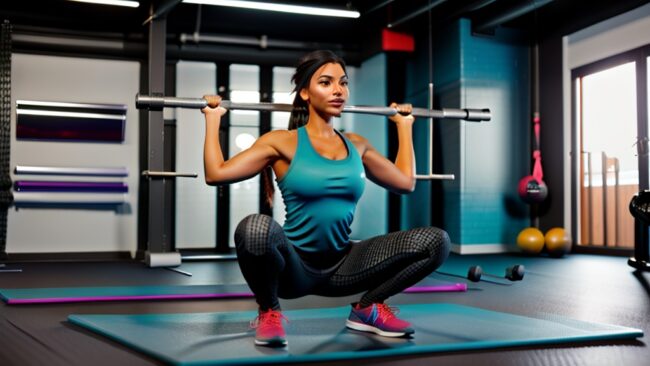Kickstart Your Fitness Journey: A Guide to Getting in Shape

Welcome, fitness enthusiasts! Are you ready to take the first step towards a healthier lifestyle? Starting a fitness journey can be a daunting task, but with the right guidance and mindset, it can be a life-changing experience. In this guide, we will provide you with the tools and resources you need to kickstart your fitness journey and achieve your health goals. Whether you’re a beginner or an experienced fitness enthusiast, this guide is tailored to meet your needs. So, let’s dive in and discover what it takes to get in shape and lead a healthier, happier life.
What is Fitness?
When we talk about fitness, we are referring to the overall state of being physically fit and healthy. It goes beyond just having a slim physique. Fitness encompasses various aspects such as cardiovascular endurance, muscular strength and endurance, flexibility, and body composition. Being fit means having the stamina and strength to perform daily activities without feeling exhausted.
Why Getting in Shape is Important
Getting in shape is not just about looking good; it has numerous benefits for both your physical and mental well-being. Regular exercise and maintaining a healthy lifestyle can improve your mood, boost your energy levels, reduce the risk of chronic diseases, enhance your immune system, and increase your overall longevity.
Benefits of Getting in Shape:
Improved mood and mental well-being.
Increased energy levels.
Reduced risk of chronic diseases.
Enhanced immune system.
Increased overall longevity.
Types of Fitness Goals
Before embarking on your fitness journey, it’s essential to understand the different types of fitness goals you can set for yourself. Each person has unique goals and aspirations when it comes to fitness, and it’s important to determine what you want to achieve.
Understanding Different Fitness Goals:
Weight loss and body composition: Shedding excess weight and building lean muscle mass.
Cardiovascular fitness: Improving your heart and lung health.
Strength and muscle gain: Building muscle strength and increasing overall muscle mass.
Flexibility: Increasing your range of motion and improving muscle elasticity.
Examples of Fitness Goals:
Losing 10 pounds in three months.
Completing a 5K run within a specific time frame.
Increasing your maximum bench press weight by 20 pounds.
Being able to touch your toes without feeling any tension.
How to Get Started
Now that you have a clear understanding of fitness and have identified your goals, it’s time to get started on your fitness journey. The key to starting off right is by setting realistic fitness goals, creating a workout plan, and finding the right exercise routine for you.
Setting Realistic Fitness Goals:
Setting realistic goals is crucial to stay motivated and avoid disappointment. Break your goals into smaller, achievable milestones, and track your progress along the way. This will enable you to celebrate every small victory and keep pushing yourself towards your ultimate goal.
Creating a Workout Plan:
Designing a workout plan tailored to your goals and fitness level is essential. Start with a mix of cardiovascular exercises, strength training, and flexibility exercises. Gradually increase the intensity and duration of your workouts over time. Remember to include rest days to allow your body to recover and prevent overexertion.
Finding the Right Exercise Routine:
The right exercise routine is one that you enjoy and can stick to in the long run. Experiment with different types of exercises, such as running, swimming, cycling, weightlifting, yoga, or dance, to find what works best for you. Don’t be afraid to try new activities and mix things up to keep yourself engaged and motivated.
Nutrition and Fitness
Exercise alone is not enough to achieve optimal fitness. Proper nutrition plays a significant role in fueling your workouts, aiding in muscle recovery, and maintaining a healthy weight. It’s essential to have a balanced diet that includes a variety of nutrients.
Importance of a Healthy Diet:
A healthy diet provides the necessary nutrients your body needs to function at its best. It helps in maintaining a healthy weight, reducing the risk of chronic diseases, and supporting muscle growth and repair. Aim to include whole foods such as fruits, vegetables, lean proteins, whole grains, and healthy fats in your diet.
Tips for Eating Well:
Stay hydrated by drinking plenty of water throughout the day.
Include protein-rich foods such as chicken, fish, tofu, eggs, or beans in your meals.
Opt for complex carbohydrates like whole grains, sweet potatoes, and legumes.
Incorporate a variety of fruits and vegetables for essential vitamins and minerals.
Limit processed foods and sugary drinks.
Tracking Progress
Tracking your progress is crucial for staying motivated and evaluating your fitness journey’s effectiveness. There are various tools and techniques you can use to track your fitness progress and make adjustments as needed.
Tools for Tracking Fitness Progress:
Fitness apps: Use mobile apps that allow you to track your workouts, calorie intake, and progress.
Progress photos: Take regular photos to document physical changes and compare them over time.
Fitness trackers: Invest in wearable devices that monitor your steps, heart rate, and other fitness metrics.
Fitness journals: Keep a journal to log your workouts, measurements, and how you feel after each session.
How to Stay Motivated:
Staying motivated can be challenging, especially when faced with obstacles or setbacks. Here are some tips to help you stay motivated throughout your fitness journey:
Set short-term goals to celebrate small achievements along the way.
Find a workout buddy or join a fitness community for support and accountability.
Mix up your workout routine to prevent boredom.
Reward yourself after reaching a significant milestone.
Celebrating Milestones:
Take the time to celebrate your milestones and achievements. Whether it’s losing a certain amount of weight, running a marathon, or fitting into a smaller clothing size, acknowledge your hard work and dedication. Treat yourself to something you enjoy, such as a massage, new workout gear, or a relaxing day off.
Common Fitness Mistakes to Avoid
In the pursuit of fitness, it’s important to be aware of common mistakes that can hinder your progress or lead to injury. Here are a few common fitness mistakes to avoid:
Overtraining: Giving your body adequate rest and recovery is crucial for preventing overuse injuries and fatigue.
Neglecting proper form: Using incorrect form during exercises can lead to injuries. Focus on proper technique and consult a trainer if needed.
Ignoring nutrition: Proper nutrition is essential for fueling your workouts and supporting your overall fitness goals.
Setting unrealistic expectations: Setting unrealistic goals can lead to frustration and burnout. Set achievable goals that align with your abilities.
Fitness Equipment and Gear
While you don’t necessarily need fancy equipment to get in shape, having some essential fitness gear can enhance your workouts and make them more effective. Here are a few pieces of equipment that can be helpful:
Essential Equipment for Exercise:
Dumbbells or resistance bands: For strength training exercises.
Yoga mat: For yoga and floor exercises.
Running shoes: Provide proper support and cushioning during cardio activities.
Jump rope: A simple and effective tool for cardiovascular workouts.
Foam roller: Helps with muscle recovery and reduces muscle soreness.
Tips for Choosing Quality Fitness Gear:
Consider your specific needs and goals when selecting fitness gear.
Read reviews and compare different brands for quality and durability.
Seek advice from fitness professionals for recommendations.
Invest in gear that suits your budget and is versatile enough for varied workouts.
Fitness Hacks and Strategies
Sometimes, we all need a little extra help to fit our workouts into our busy lives. Here are a few time-saving workout tips and strategies to make exercise more manageable:
Time-Saving Workout Tips:
Opt for high-intensity interval training (HIIT) workouts for quick and effective workouts.
Combine strength and cardio exercises for a multifunctional workout.
Utilize time-saving workout apps or online videos for guided workouts.
Make use of your lunch break for a quick walk or workout session.
Tips for Exercising on a Busy Schedule:
Prioritize your workouts and schedule them in your calendar like any other appointment.
Wake up a little earlier to fit in a morning workout.
Break up your workouts into shorter sessions throughout the day.
Make exercise a social activity by meeting friends for an active outing or workout class.
https://fiscalfitnessflow.com/index.php/2023/12/06/breathing-techniques-for-stress-relief/
Incorporating Exercise into Daily Life
Maintaining an active lifestyle doesn’t just end at the gym; it’s important to incorporate exercise into your daily routine, even outside of dedicated workout sessions.
How to Stay Active at Work:
Take regular breaks to stretch and walk around.
Utilize standing desks or stability balls instead of sitting for long periods.
Use stairs instead of elevators when possible.
Consider cycling or walking to work if feasible.
Organize walking or standing meetings instead of sitting.
Fitness Tips for Travelers:
Research fitness facilities or classes available at your travel destination.
Pack lightweight workout gear or resistance bands for easy workouts on the go.
Explore the city or area on foot or by bike.
Utilize hotel gyms or outdoor spaces for workouts.
Stay active during long flights by stretching and walking in the plane cabin.
Fitness Resources and Support
In today’s digital age, there are numerous fitness resources and communities available to provide support, guidance, and motivation throughout your fitness journey.
Online Fitness Communities and Apps:
Join online fitness communities or forums where you can connect with like-minded individuals who can offer advice and support.
Download fitness apps that provide workout programs, tracking tools, and motivational content.
Hiring a Personal Trainer:
If you prefer one-on-one guidance and personalized workouts, hiring a personal trainer can be beneficial. A trainer can help you develop a tailored exercise plan, teach proper form and technique, and provide the accountability and motivation you need.
Injury Prevention and Recovery
To maintain progress and stay consistent, it’s important to prioritize injury prevention and recovery. Here are some tips to help you prevent injuries and recover effectively.
Preventing Exercise Injuries:
Warm up before each workout to prepare your muscles and joints.
Use appropriate equipment and gear for your workouts.
Gradually increase the intensity and duration of your workouts to avoid overexertion.
Listen to your body and rest when needed.
Incorporate stretching and mobility exercises to improve flexibility.
Recovering from Injuries:
Seek medical attention for any significant injuries or persistent pain.
Follow your healthcare professional’s guidance for recovery and rehabilitation.
Modify your workouts to accommodate your injury while still staying active.
Focus on nutrition and sleep to support healing and recovery.
Staying Consistent and Maintaining Progress
Achieving your fitness goals is not a one-time event but rather an ongoing commitment. Here are some tips to help you stay consistent and maintain your progress:
How to Make Fitness a Habit:
Schedule your workouts in advance and treat them as non-negotiable appointments.
Find activities you genuinely enjoy to stay motivated.
Focus on the long-term benefits of exercise for improved health and well-being.
Surround yourself with supportive and like-minded individuals.
Overcoming Plateaus:
At times, you may hit a plateau where progress seems to stagnate. Don’t get discouraged; try implementing these strategies to overcome plateaus:
Reevaluate your goals and make necessary adjustments.
Vary your workout routine with new exercises or techniques.
Increase the intensity or duration of your workouts.
Seek guidance from fitness professionals or trainers.
Wrap Up
Embarking on your fitness journey can be both exciting and challenging. Remember to start with a clear understanding of fitness, set realistic goals, create a tailored workout plan, and prioritize proper nutrition. Make use of various tools and resources to track your progress, stay motivated, and celebrate your milestones. Avoid common fitness mistakes, invest in quality gear, and incorporate exercise into your daily life. Seek support from online communities or consider hiring a personal trainer for additional guidance. Prioritize injury prevention and recovery, and most importantly, stay consistent and enjoy the process of achieving your fitness goals.




